Impacts of a Recent Interdecadal Shift in the Summer Arctic Dipole on the Variability in Atmospheric Circulation over Eurasia
Abstract
1. Introduction
2. Data and Methods
3. Results
3.1. Dipole Circulation Anomaly in the Arctic
3.2. Associations with Climate Variability over Eurasia
3.2.1. Impact on the Summer SAT over Eurasia
3.2.2. Impact on the Summer Precipitation over Eurasia
3.3. Possible Mechanisms for the Relationship between AD and Climate Variability in Eurasia
4. Conclusions and Discussion
Author Contributions
Funding
Institutional Review Board Statement
Informed Consent Statement
Data Availability Statement
Conflicts of Interest
References
- Wettstein, J.J.; Deser, C. Internal Variability in Projections of Twenty-First-Century Arctic Sea Ice Loss: Role of the Large-Scale Atmospheric Circulation. J. Clim. 2014, 27, 527–550. [Google Scholar] [CrossRef]
- Zhou, F.; Liu, M.-H.; Shi, J.; Zhao, M.-Y. Long-Lasting Impact of Winter North Atlantic Oscillation on Barents-Kara Sea Ice Anomaly in Recent Decades. Environ. Res. Lett. 2023, 18, 044015. [Google Scholar] [CrossRef]
- Thompson, D.W.J.; Wallace, J.M. The Arctic Oscillation Signature in the Wintertime Geopotential Height and Temperature Fields. Geophys. Res. Lett. 1998, 25, 1297–1300. [Google Scholar] [CrossRef]
- Mori, M.; Watanabe, M.; Shiogama, H.; Inoue, J.; Kimoto, M. Robust Arctic Sea-Ice Influence on the Frequent Eurasian Cold Winters in Past Decades. Nat. Geosci. 2014, 7, 869–873. [Google Scholar] [CrossRef]
- Kim, B.M.; Son, S.W.; Min, S.K.; Jeong, J.H.; Kim, S.J.; Zhang, X.; Shim, T.; Yoon, J.H. Weakening of the Stratospheric Polar Vortex by Arctic Sea-Ice Loss. Nat. Commun. 2014, 5, 4646. [Google Scholar] [CrossRef] [PubMed]
- Wu, B.; Wang, J.; Walsh, J.E. Dipole Anomaly in the Winter Arctic Atmosphere and Its Association with Sea Ice Motion. J. Clim. 2006, 19, 210–225. [Google Scholar] [CrossRef]
- Overland, J.E.; Francis, J.A.; Hanna, E.; Wang, M. The Recent Shift in Early Summer Arctic Atmospheric Circulation. Geophys. Res. Lett. 2012, 39, L19804. [Google Scholar] [CrossRef]
- Cai, L.; Alexeev, V.A.; Walsh, J.E.; Bhatt, U.S. Patterns, Impacts, and Future Projections of Summer Variability in the Arctic from CMIP5 Models. J. Clim. 2018, 31, 9815–9833. [Google Scholar] [CrossRef]
- Fan, T.; Huang, F.; Zhou, X. Response of the Dominant Modes of Atmospheric Circulation in the Northern Hemisphere to a Projected Arctic Sea Ice Loss in 2007. J. Ocean Univ. China 2019, 18, 589–595. [Google Scholar] [CrossRef]
- Zhang, R. Mechanisms for Low-Frequency Variability of Summer Arctic Sea Ice Extent. Proc. Natl. Acad. Sci. USA 2015, 112, 4570–4575. [Google Scholar] [CrossRef]
- Overland, J.E.; Wood, K.R.; Wang, M. Warm Arctic-Cold Continents: Climate Impacts of the Newly Open Arctic Sea. Polar Res. 2011, 30, 15787. [Google Scholar] [CrossRef]
- Alexeev, V.A.; Walsh, J.E.; Ivanov, V.V.; Semenov, V.A.; Smirnov, A.V. Warming in the Nordic Seas, North Atlantic Storms and Thinning Arctic Sea Ice. Environ. Res. Lett. 2017, 12, 084011. [Google Scholar] [CrossRef]
- Wang, J.; Zhang, J.; Watanabe, E.; Ikeda, M.; Mizobata, K.; Walsh, J.E.; Bai, X.; Wu, B. Is the Dipole Anomaly a Major Driver to Record Lows in Arctic Summer Sea Ice Extent? Geophys. Res. Lett. 2009, 36, L05706. [Google Scholar] [CrossRef]
- Wu, B.; Overland, J.E.; D’Arrigo, R. Anomalous Arctic Surface Wind Patterns and Their Impacts on September Sea Ice Minima and Trend. Tellus A Dyn. Meteorol. Oceanogr. 2012, 64, 18590. [Google Scholar] [CrossRef]
- Stroeve, J.C.; Kattsov, V.; Barrett, A.; Serreze, M.; Pavlova, T.; Holland, M.; Meier, W.N. Trends in Arctic Sea Ice Extent from CMIP5, CMIP3 and Observations. Geophys. Res. Lett. 2012, 39, L16502. [Google Scholar] [CrossRef]
- Coumou, D.; Rahmstorf, S. A Decade of Weather Extremes. Nat. Clim. Chang. 2012, 2, 491–496. [Google Scholar] [CrossRef]
- Yu, L.; Yang, Q.; Zhou, M.; Zeng, X.; Lenschow, D.H.; Wang, X.; Han, B. The Intraseasonal and Interannual Variability of Arctic Temperature and Specific Humidity Inversions. Atmosphere 2019, 10, 214. [Google Scholar] [CrossRef]
- Wu, B.; Yang, K.; Francis, J.A. Summer Arctic Dipole Wind Pattern Affects the Winter Siberian High. Int. J. Climatol. 2016, 36, 4187–4201. [Google Scholar] [CrossRef]
- Polyakov, I.V.; Ingvaldsen, R.B.; Pnyushkov, A.V.; Bhatt, U.S.; Francis, J.A.; Janout, M.; Kwok, R.; Skagseth, Ø. Fluctuating Atlantic Inflows Modulate Arctic Atlantification. Science 2023, 979, 972–979. [Google Scholar] [CrossRef]
- Chen, S.; Wu, R.; Chen, W.; Yu, B. Influence of Winter Arctic Sea Ice Concentration Change on the El Niño–Southern Oscillation in the Following Winter. Clim. Dyn. 2020, 54, 741–757. [Google Scholar] [CrossRef]
- Screen, J.A. Far-Flung Effects of Arctic Warming. Nat. Geosci. 2017, 10, 253–254. [Google Scholar] [CrossRef]
- Coumou, D.; Di Capua, G.; Vavrus, S.; Wang, L.; Wang, S. The Influence of Arctic Amplification on Mid-Latitude Summer Circulation. Nat. Commun. 2018, 9, 2959. [Google Scholar] [CrossRef] [PubMed]
- Ding, S.; Wu, B.; Chen, W. Dominant Characteristics of Early Autumn Arctic Sea Ice Variability and Its Impact on Winter Eurasian Climate. J. Clim. 2021, 34, 1825–1846. [Google Scholar] [CrossRef]
- Tang, Q.; Zhang, X.; Francis, J.A. Extreme Summer Weather in Northern Mid-Latitudes Linked to a Vanishing Cryosphere. Nat. Clim. Chang. 2014, 4, 45–50. [Google Scholar] [CrossRef]
- Liu, L.; Wu, B.; Ding, S. On the Association of the Summertime Shortwave Cloud Radiative Effect in Northern Russia with Atmospheric Circulation and Climate over East Asia. Geophys. Res. Lett. 2022, 49, e2021GL096606. [Google Scholar] [CrossRef]
- Du, Y.; Zhang, J.; Zhao, S.; Chen, Z. A Mechanism of Spring Barents Sea Ice Effect on the Extreme Summer Droughts in Northeastern China. Clim. Dyn. 2021, 58, 1033–1048. [Google Scholar] [CrossRef]
- Li, J.; Zheng, F.; Sun, C.; Feng, J.; Wang, J. Pathways of Influence of the Northern Hemisphere Mid-High Latitudes on East Asian Climate: A Review. Adv. Atmos. Sci. 2019, 36, 902–921. [Google Scholar] [CrossRef]
- Peng, Y. Simulated Interannual Teleconnection between the Summer North Atlantic Oscillation and Summer Precipitation in Eastern China During the Last Millennium. Geophys. Res. Lett. 2018, 45, 7741–7747. [Google Scholar] [CrossRef]
- Liu, L.; Wu, B.; Ding, S. Combined Impact of Summer NAO and Northern Russian Shortwave Cloud Radiative Effect on Eurasian Atmospheric Circulation. Environ. Res. Lett. 2023, 18, 14015. [Google Scholar] [CrossRef]
- Hersbach, H.; Bell, B.; Berrisford, P.; Hirahara, S.; Horányi, A.; Muñoz-Sabater, J.; Nicolas, J.; Peubey, C.; Radu, R.; Schepers, D.; et al. The ERA5 Global Reanalysis. Q. J. R. Meteorol. Soc. 2020, 146, 1999–2049. [Google Scholar] [CrossRef]
- North, G.R.; Bell, T.L.; Cahalan, R.F.; Moeng, F.J. Sampling Errors in the Estimation of Empirical Orthogonal Functions. Mon. Weather Rev. 1982, 110, 699–706. [Google Scholar] [CrossRef]
- Choi, N.; Kim, K.M.; Lim, Y.K.; Lee, M.I. Decadal Changes in the Leading Patterns of Sea Level Pressure in the Arctic and Their Impacts on the Sea Ice Variability in Boreal Summer. Cryosphere 2019, 13, 3007–3021. [Google Scholar] [CrossRef]
- Serreze, M.C.; Stroeve, J.; Barrett, A.P.; Boisvert, L.N. Summer Atmospheric Circulation Anomalies over the Arctic Ocean and Their Influences on September Sea Ice Extent: A Cautionary Tale. J. Geophys. Res. Atmos. 2016, 121, 11–463. [Google Scholar] [CrossRef]
- Wu, B.; Li, Z. Possible Impacts of Anomalous Arctic Sea Ice Melting on Summer Atmosphere. Int. J. Climatol. 2022, 42, 1818–1827. [Google Scholar] [CrossRef]
- Wu, B. Winter Atmospheric Circulation Anomaly Associated with Recent Arctic Winter Warm Anomalies. J. Clim. 2017, 30, 8469–8479. [Google Scholar] [CrossRef]
- Takaya, K.; Nakamura, H. A Formulation of a Phase-Independent Wave-Activity Flux for Stationary and Migratory Quasigeostrophic Eddies on a Zonally Varying Basic Flow. J. Atmos. Sci. 2001, 58, 608–627. [Google Scholar] [CrossRef]
- Screen, J.A. Influence of Arctic Sea Ice on European Summer Precipitation. Environ. Res. Lett. 2013, 8, 044015. [Google Scholar] [CrossRef]
- Wang, B.; Wu, R.; Lau, K.M. Interannual Variability of the Asian Summer Monsoon: Contrasts between the Indian and the Western North Pacific-East Asian Monsoons. J. Clim. 2001, 14, 4073–4090. [Google Scholar] [CrossRef]
- Sun, L.; Shen, B.; Sui, B.; Huang, B. The Influences of East Asian Monsoon on Summer Precipitation in Northeast China. Clim. Dyn. 2017, 48, 1647–1659. [Google Scholar] [CrossRef]
- Hong, X.; Lu, R.; Chen, S.; Li, S. The Relationship between the North Atlantic Oscillation and the Silk Road Pattern in Summer. J. Clim. 2022, 35, 3091–3102. [Google Scholar] [CrossRef]
- Zheng, F.; Li, J.; Li, Y.; Zhao, S.; Deng, D. Influence of the Summer NAO on the Spring-NAO-Based Predictability of the East Asian Summer Monsoon. J. Appl. Meteorol. Climatol. 2016, 55, 1459–1476. [Google Scholar] [CrossRef]
- Yang, X.Y.; Wang, G.; Keenlyside, N. The Arctic Sea Ice Extent Change Connected to Pacific Decadal Variability. Cryosphere 2020, 14, 693–708. [Google Scholar] [CrossRef]

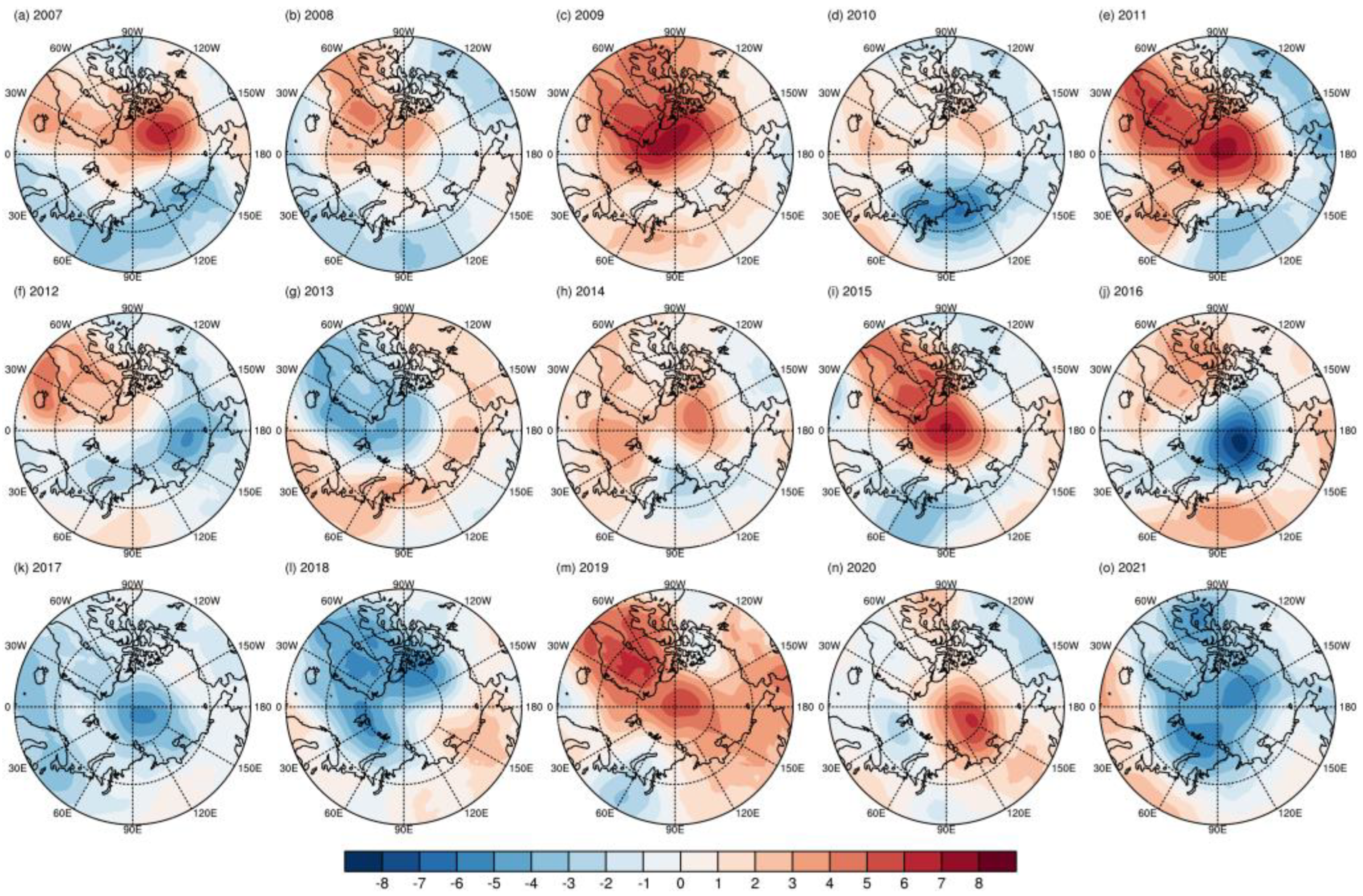

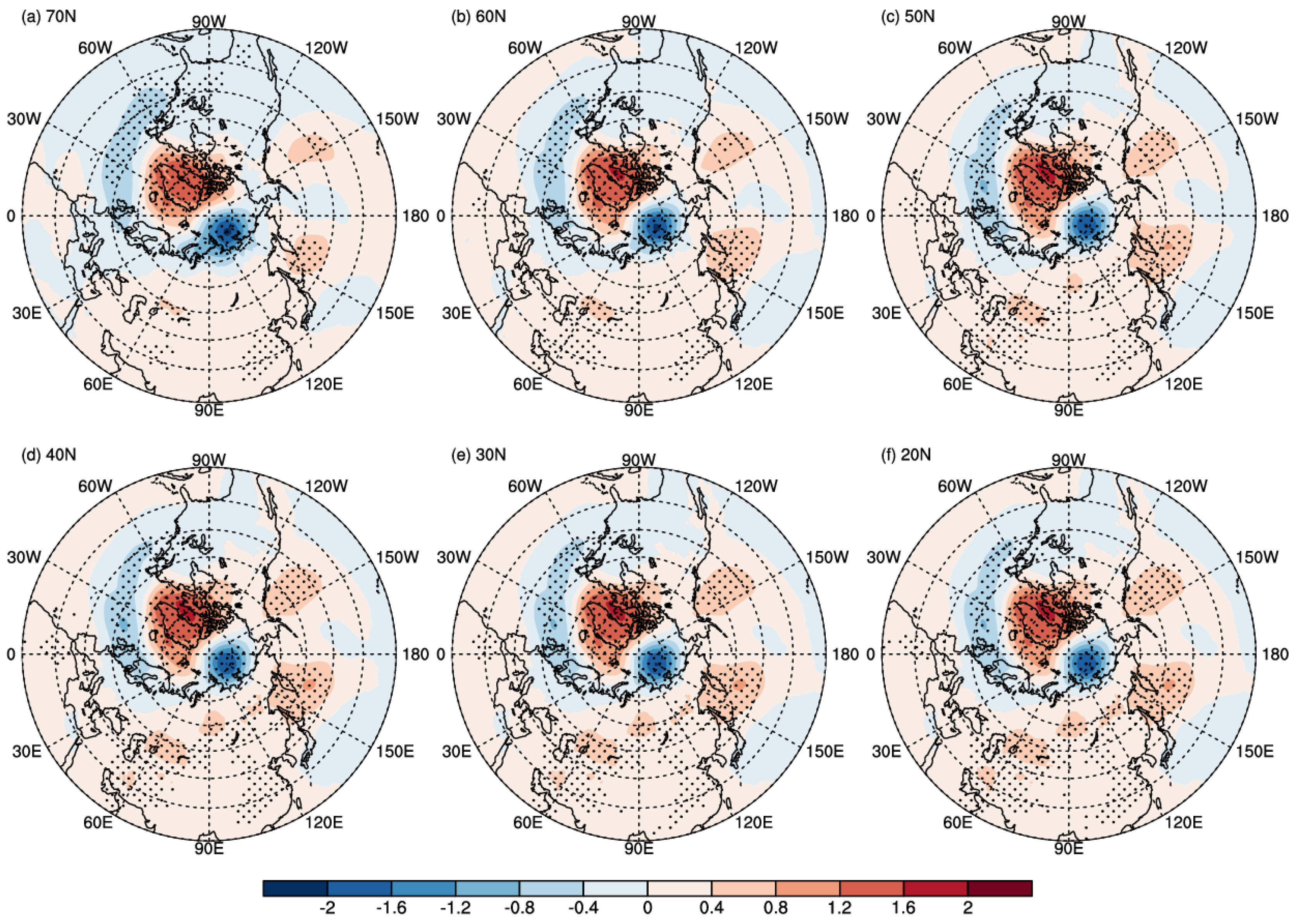
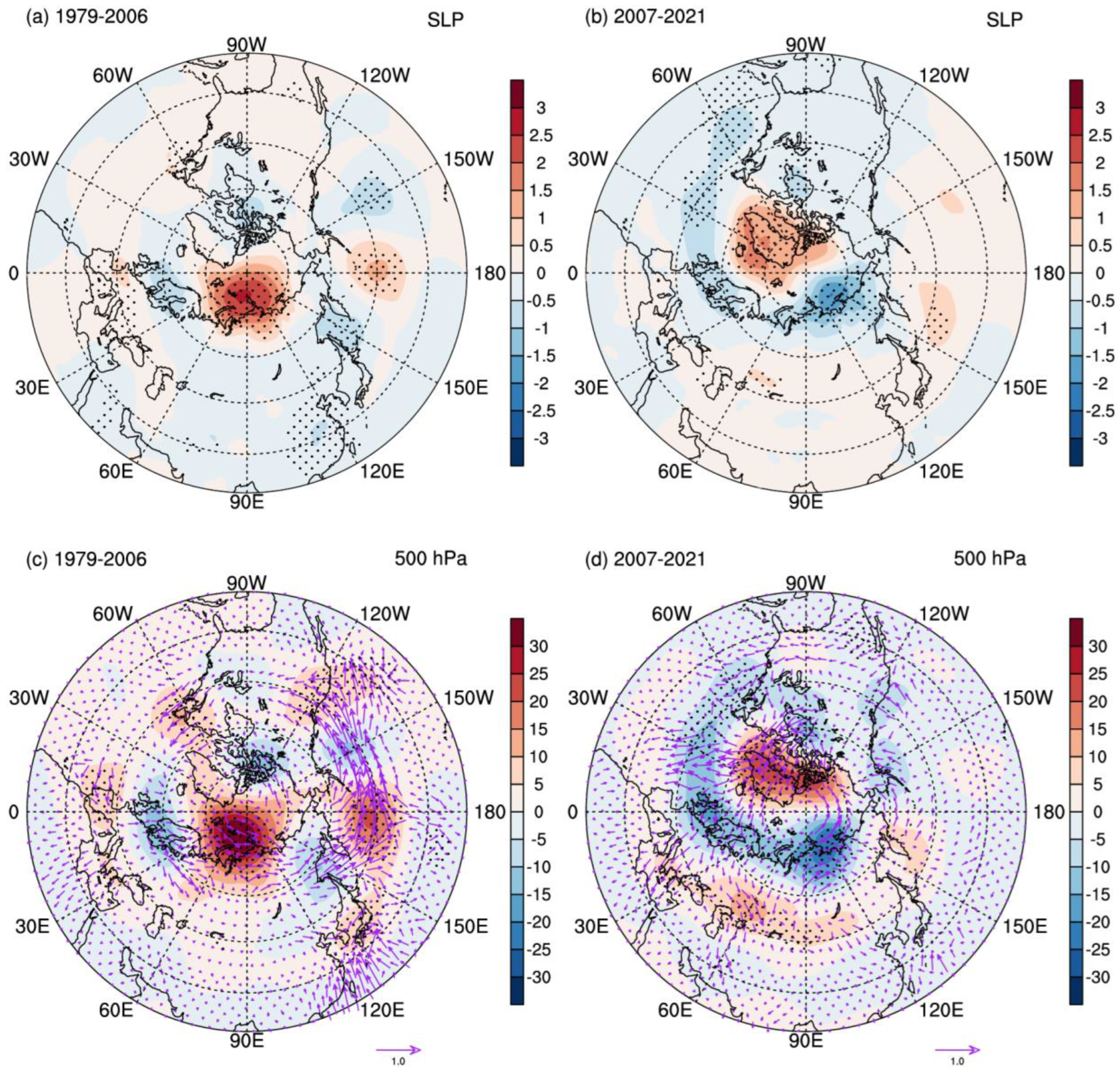


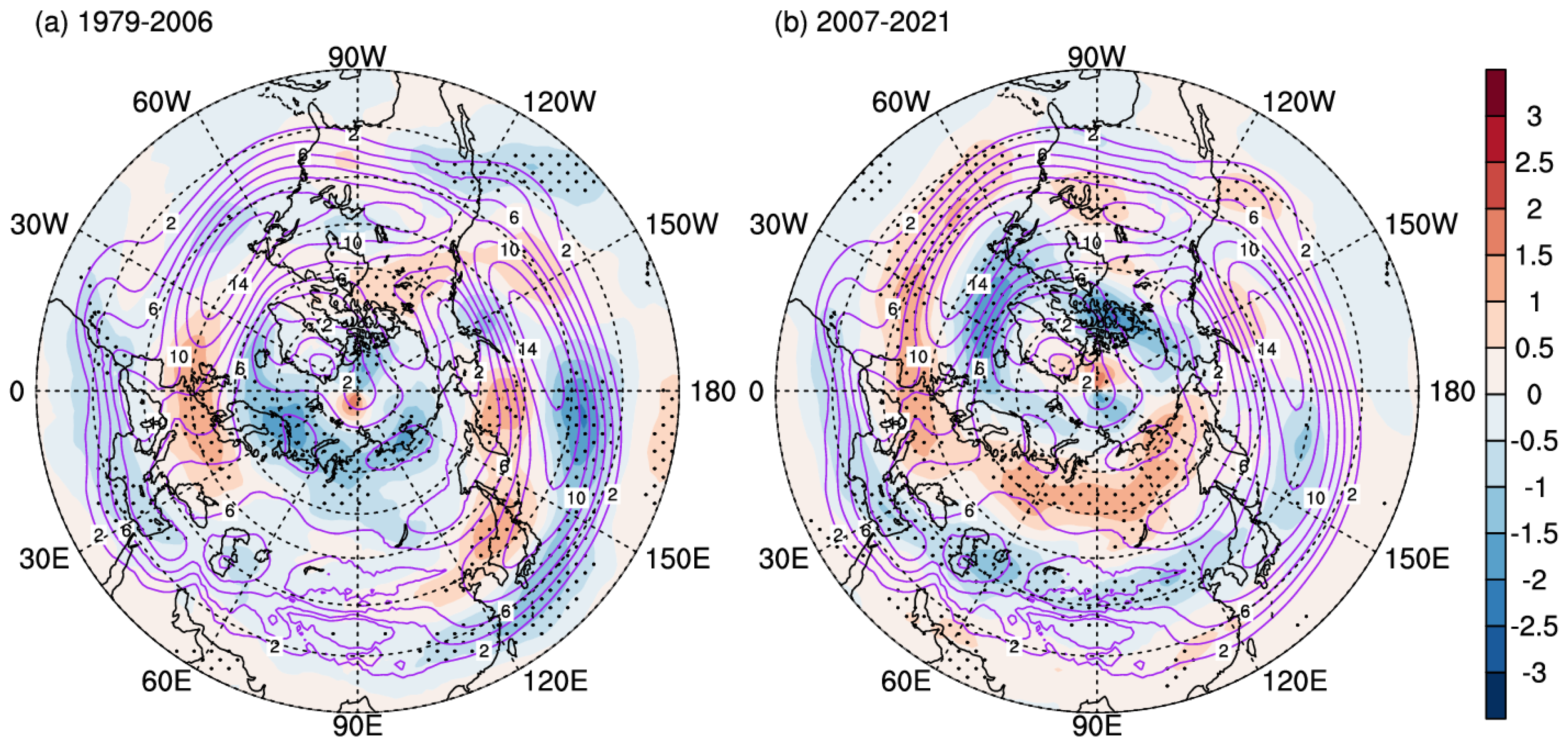

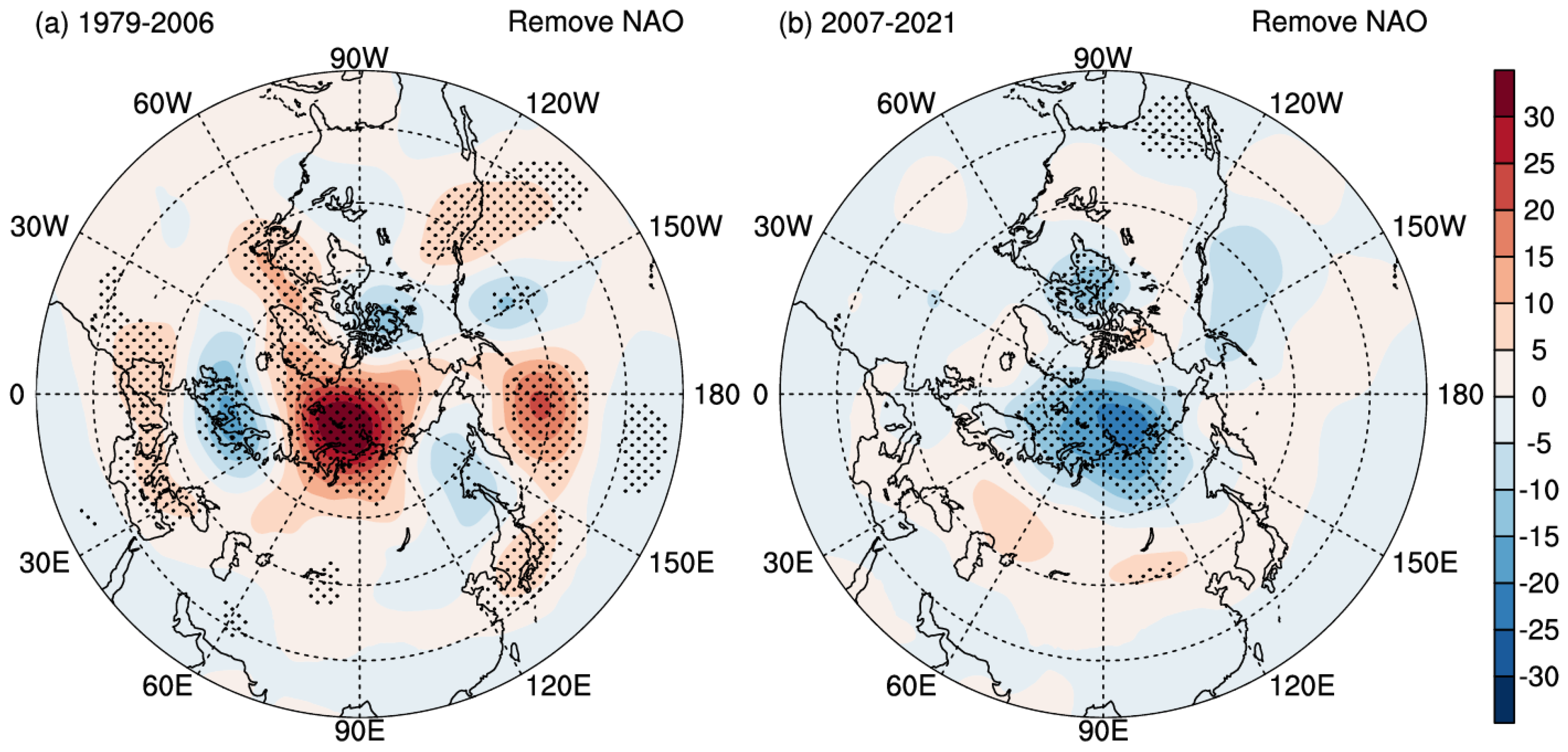
Disclaimer/Publisher’s Note: The statements, opinions and data contained in all publications are solely those of the individual author(s) and contributor(s) and not of MDPI and/or the editor(s). MDPI and/or the editor(s) disclaim responsibility for any injury to people or property resulting from any ideas, methods, instructions or products referred to in the content. |
© 2024 by the authors. Licensee MDPI, Basel, Switzerland. This article is an open access article distributed under the terms and conditions of the Creative Commons Attribution (CC BY) license (https://creativecommons.org/licenses/by/4.0/).
Share and Cite
Zhang, X.; Pang, X.; Zhang, X.; Wu, B. Impacts of a Recent Interdecadal Shift in the Summer Arctic Dipole on the Variability in Atmospheric Circulation over Eurasia. Atmosphere 2024, 15, 71. https://doi.org/10.3390/atmos15010071
Zhang X, Pang X, Zhang X, Wu B. Impacts of a Recent Interdecadal Shift in the Summer Arctic Dipole on the Variability in Atmospheric Circulation over Eurasia. Atmosphere. 2024; 15(1):71. https://doi.org/10.3390/atmos15010071
Chicago/Turabian StyleZhang, Xuanwen, Xueqi Pang, Xiang Zhang, and Bingyi Wu. 2024. "Impacts of a Recent Interdecadal Shift in the Summer Arctic Dipole on the Variability in Atmospheric Circulation over Eurasia" Atmosphere 15, no. 1: 71. https://doi.org/10.3390/atmos15010071
APA StyleZhang, X., Pang, X., Zhang, X., & Wu, B. (2024). Impacts of a Recent Interdecadal Shift in the Summer Arctic Dipole on the Variability in Atmospheric Circulation over Eurasia. Atmosphere, 15(1), 71. https://doi.org/10.3390/atmos15010071





